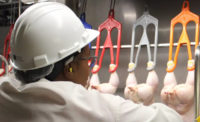Last month, the USDA Food Safety and Inspection Service (FSIS) published the final rule for the New Swine Slaughter Inspection System (NSIS), a rule that requires additional pathogen sampling for swine slaughter establishments and eliminates the numbers of FSIS inspectors, with a goal toward modernizing swine slaughter safety and more efficiently utilizing agency resources.
Pursuant to the new rule, establishments must enhance Hazard Analysis and Critical Control Point (HACCP) plans, Sanitation Standard Operating Procedures (SSOPs), and other preventative controls to minimize contamination throughout the production process. Establishments must also prove the measures are effective in controlling illness-causing pathogens. Additionally, and most controversially, establishments will have the option to give their employees certain tasks historically performed by FSIS inspectors; however, FSIS inspectors would continue to conduct 100 percent of ante-mortem and carcass inspections.
The NSIS has met with significant controversy — at least one lawsuit challenging the law has already been filed. Regardless of one’s position with respect to the specifics of the new rule, few would argue against the need to modernize our food safety system. Notably, the NSIS represents the first major overhaul of federal swine slaughter regulations in half a century. During that time, our understanding of food safety, and the correlating advancements in science and technology, have fundamentally changed the food safety landscape. In short, the type of “see and smell” inspections the federal government by necessity relied on three decades ago are largely obsolete today. In other words, using on-line inspectors is increasingly a waste of FSIS’ already limited resources which could better be devoted to performing other food safety related roles.
FSIS recognizes this. In turn, the NSIS represents the culmination of a 20-year process aimed at modernizing the swine slaughter inspection system. Despite some of the backlash — much of which is based on misleading or inaccurate information — it is likely that the agency will continue reducing on-line inspectors in all sectors in the years to come. The marvels of modern science and technology will only continue to revolutionize our ability to detect and eliminate pathogens in our food. It is entirely possible that the need for on-line inspectors will disappear in the coming years. The fact is, we are continually developing much more effective ways to “see” potential risks through non-organoleptic means.
Unfortunately, in the realm of science and regulation, more effective policies are not necessarily more popular policies. Moreover, the public’s mistrust in government can make messaging manifestly more difficult. So it seems to be with the NSIS. Sensational headlines proclaiming the government is handing inspection oversight to industry are naturally met with skepticism by the public. Likewise, the nuance and scientific complexity underlying changes developed over the course of many decades are far more difficult to distill into a readily consumable format. Hopefully, we will soon have a technology for that as well. NP





Report Abusive Comment